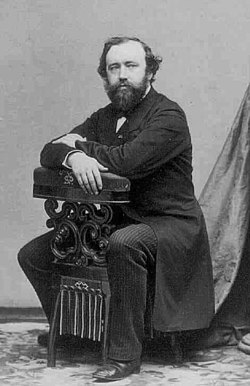Adolphe Sax
| Adolphe Sax | |
|---|---|
 |
|
| Born |
Antoine-Joseph Sax 6 November 1814 Dinant, First French Empire (now in Kingdom of Belgium) |
| Died |
c. 7 February 1894 (aged 79) Paris, French Third Republic |
| Burial place |
Cimetière de Montmartre, Paris 48°53′16″N 2°19′49″E / 48.88778°N 2.33028°E |
| Nationality | Belgian |
| Occupation | Inventor, musician, musical instrument designer |
| Known for | Inventor of the saxophone |
Antoine-Joseph "Adolphe" Sax (French pronunciation: [ɑ̃twan.ʒozɛf adɔlf saks]; 6 November 1814 – c. 7 February 1894) was a Belgian inventor and musician who invented the saxophone in 1846. He played the flute and clarinet, and his other inventions are the saxotromba, saxhorn and saxtuba.
Antoine-Joseph Sax was born on 6 November 1814, in Dinant, Belgium, to Charles-Joseph Sax and his wife. While his first name was Antoine, he was referred to as Adolphe from childhood. His father and mother were instrument designers themselves, who made several changes to the design of the horn. Adolphe began to make his own instruments at an early age, entering two of his flutes and a clarinet into a competition at the age of 15. He subsequently studied performance on those two instruments as well as voice at the Royal Conservatory of Brussels.
According to the biography of Adolphe Sax published on the city of Dinant's website, Sax faced many near-death experiences. Over the course of his childhood, he:
Also according to the biography, his mother once said that "He's a child condemned to misfortune; he won't live". His neighbors called him "little Sax, the ghost".
After leaving the Royal Conservatory of Brussels, Sax began to experiment with new instrument designs, while his parents continued to make conventional instruments to bring in money. Adolphe's first important invention was an improvement of the bass clarinet design, which he patented at the age of 24. Sax relocated permanently to Paris in 1841 and began working on a new set of instruments exhibited there in 1844. These were valved bugles, and although he had not invented the instrument itself, his examples were much more successful than those of his rivals and became known as saxhorns. They came in approximately seven different sizes, and paved the path to the creation of the flugelhorn. Today, saxhorns are sometimes used in concert bands and orchestras. The saxhorn also laid the groundwork for the modern euphonium.
...
Wikipedia
